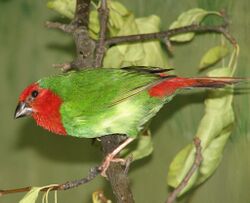Biology:Parrotfinch
| Parrotfinches | |
|---|---|

| |
| Red-throated parrotfinch (Erythrura psittacea) | |
| Scientific classification | |
| Domain: | Eukaryota |
| Kingdom: | Animalia |
| Phylum: | Chordata |
| Class: | Aves |
| Order: | Passeriformes |
| Family: | Estrildidae |
| Genus: | Erythrura Swainson, 1837 |
| Type species | |
| Erythura viridis[1] = Loxia prasina Swainson, 1837
| |
| Species | |
|
See text | |
Parrotfinches are small, colourful passerine birds belonging to the genus Erythrura in the family Estrildidae, the estrildid finches. They occur from South-east Asia to New Guinea, and many Pacific Islands. They inhabit forest, bamboo thickets and grassland and some can be found in man-made habitats such as farmland, parks and gardens. Several species are commonly kept as cagebirds.
They are 9 to 15 cm long. The plumage is usually mainly green. Most species have blue or red markings on the head and a red rump and tail. The tail is pointed and often fairly long.
Seeds, especially those of grasses, comprise the bulk of the diet. Some parrotfinches also feed on fruit and small insects. Many species forage in flocks, keeping in contact with high-pitched calls.
Three species, the green-faced, royal and pink-billed parrotfinches, are classed as vulnerable to extinction because of habitat loss and degradation.
Taxonomy
The genus Erythrura was introduced in 1837 by the English naturalist William Swainson to accommodate the pin-tailed parrotfinch. Swainson misspelled the genus name as "Erythura".[2][3] The name combines the Ancient Greek eruthros meaning "red" with -ouros meaning "-tailed".[4] The genus Erythrura is sister to the Gouldian finch which is placed in its own genus Chloebia and together the two genera form the subfamily Erythrurinae.[5]
The cladogram shown below is based on a molecular phylogenetic study of the Erythrura parrotfinches published in 2023. The Papuan parrotfinch (E. papuana) was found to embedded within the broadly distributed blue-faced parrotfinch (E. trichroa).[6]
| Erythrura |
| ||||||||||||||||||||||||||||||||||||||||||||||||||||||||||||
Species
The genus contains 12 species.[7]
| Image | Scientific name | Common Name | Distribution |
|---|---|---|---|
 |
Pin-tailed parrotfinch | Erythrura prasina | Malaysia, Brunei, Cambodia, Indonesia, Laos, Burma, Vietnam, Thailand and China |
| Green-faced parrotfinch | Erythrura viridifacies | northern Philippines, around Luzon, Negros and Panay | |
 |
Tawny-breasted parrotfinch or green-tailed parrotfinch | Erythrura hyperythra | Indonesia, Malaysia and the Philippines |
 |
Red-throated parrotfinch | Erythrura psittacea | New Caledonia |
 |
Fiji parrotfinch (split from red-headed parrotfinch) | Erythrura pealii | Fiji (Viti Levu, Vanua Levu, Taveuni and Kadavu) |
| Royal parrotfinch (split from red-headed parrotfinch) | Erythrura regia | Vanuatu | |
| Red-headed parrotfinch | Erythrura cyaneovirens | Samoan Islands | |
 |
Pink-billed parrotfinch | Erythrura kleinschmidti | Viti Levu, Fiji |
 |
Tricolored parrotfinch or three-coloured parrotfinch | Erythrura tricolor | Timor and the southern Moluccas |
| Red-eared parrotfinch or Mount Katanglad parrotfinch | Erythrura coloria | Mindanao in the Philippines | |
| Papuan parrotfinch | Erythrura papuana | New Guinea | |
 |
Blue-faced parrotfinch | Erythrura trichroa | north-eastern Australia, Japan, Indonesia, Federated States of Micronesia, France (introduced), New Caledonia, Palau, Papua New Guinea, the Solomon Islands and Vanuatu |
References
- ↑ "Estrildidae". The Trust for Avian Systematics. https://www.aviansystematics.org/4th-edition-checklist?viewfamilies=191.
- ↑ Swainson, William John (1837). On the Natural History and Classification of Birds. 2. London: John Taylor. p. 280. https://www.biodiversitylibrary.org/page/41945058.
- ↑ Paynter, Raymond A. Jr, ed (1968). Check-List of Birds of the World. 14. Cambridge, Massachusetts: Museum of Comparative Zoology. p. 362. https://www.biodiversitylibrary.org/page/14481563.
- ↑ Jobling, James A. (2010). The Helm Dictionary of Scientific Bird Names. London: Christopher Helm. p. 151. ISBN 978-1-4081-2501-4.
- ↑ Olsson, Urban; Alström, Per (2020). "A comprehensive phylogeny and taxonomic evaluation of the waxbills (Aves: Estrildidae)". Molecular Phylogenetics and Evolution 146: 106757. doi:10.1016/j.ympev.2020.106757. http://uu.diva-portal.org/smash/get/diva2:1446205/FULLTEXT01.
- ↑ DeCicco, L.H.; DeRaad, D.A.; Ostrow, E.N.; Moyle, R.G. (2023). "A complete species-level phylogeny of the Erythrura parrotfinches (Aves: Estrildidae)". Molecular Phylogenetics and Evolution: 107883. doi:10.1016/j.ympev.2023.107883.
- ↑ Gill, Frank; Donsker, David; Rasmussen, Pamela, eds (July 2021). "Waxbills, parrotfinches, munias, whydahs, Olive Warbler, accentors, pipits". IOC World Bird List Version 11.2. International Ornithologists' Union. https://www.worldbirdnames.org/bow/waxbills/.
External links
Wikidata ☰ Q931426 entry
 |

